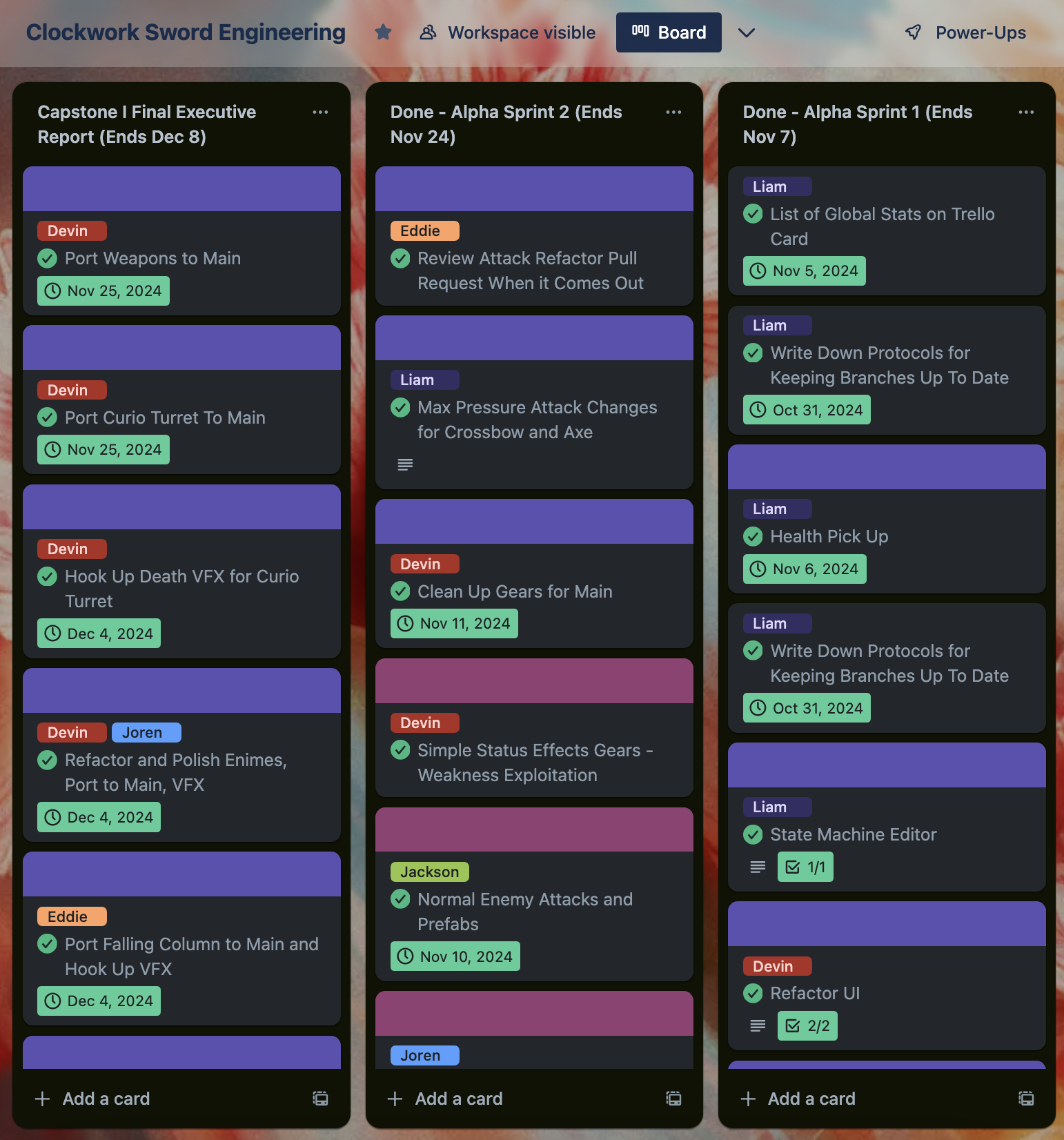
Capstone - Play on Steam or Epic!
Clockwork Sword
Scroll ↓
Role(s): Producer
Team Size: 37
Production Time: 8 months
Date of Completion: May 2025
Engine: Unity
Platform: PC
Slash, stab, and shoot your way through a multi-tiered museum filled with corrupted automata, customizing your weapon with the scraps of the fallen. Clockwork Sword is a thrilling isometric hack and slash, in which you utilize combinations of weapons and elements to conquer your foes.
Clockwork Sword is a thrilling isometric hack and slash, in which you utilize combinations of weapons and elements to conquer your foes.
Contributions
Engineering Producer for Phase 1, responsible for 9 team members
Art Producer for Phase 2, responsible for 13 team members
Held weekly meetings with team members to ensure that the project was on track
Met with team members individually, twice a week for Artists and once a week for Engineers, to check in on their progress and give guidance and feedback on their tasks
Assigned and kept track of Engineering tasks progress through Trello
Created and assigned Art tasks using Discord, providing the necessary reference material, and tracked task progress using spreadsheets
Ensure that team members I am responsible for have all the information that they need to succeed
As the Producer…
I learned how to bring a struggling area that was behind schedule back on track during this project. I oversaw two distinct teams throughout the lifecycle of this project. During Phase 1, I oversaw a team of engineers and support them to stay on top of deadlines. During Phase 2, I guided a lagging Art team to get back on schedule.
In Phase 1, I led a team of nine engineers, collaborating closely with our Engineering Lead, Liam, through weekly meetings to align on priorities and ensure effective task delegation. I conducted individual check-ins with each team member at least once a week to monitor progress, address challenges, and provide support where needed.
Organizing and clearly communicating tasks through our team’s Trello board was key. Trello served as a centralized platform for tracking assignments and sprint progress. Each task card included detailed descriptions and status updates, which I maintained regularly to ensure transparency and accountability across the team. Given the academic nature of this project, adherence to deadlines was critical, with no flexibility for extensions. I made it a priority to ensure that all team members had the resources and clarity they needed to stay on track and deliver high-quality work on time.
After Phase 1, all disciplines of the project including engineering, audio, and design were on track except Art. The Art team lacked the needed structure and organization to catch up on passed deadlines and expectations. The production team decided that I would be better suited on the art team to bring the art team back on schedule.
In Phase 2, I transitioned to leading the Art team, which consisted of 13 artists. After working with the art team, I quickly saw they were not lazy or incapable. Some of these artists were brilliant in their skills! I was amazed at what they were able to create with more frequent and clear communication and organization in completing tasks when broken down to the appropriate sizes.
One of my first initiatives was to restructure and standardize the assignment delegation process, addressing the previous system’s inconsistencies that had caused confusion and inefficiencies. This reorganization significantly streamlined the art pipeline, making it easier for artists to understand their responsibilities and improving overall workflow efficiency. As a result, the team was able to stay on schedule and meet key project milestones.
I was responsible for creating and managing the Art team's task-tracking system, which I implemented using Google Sheets. This tracker provided visibility into task deadlines and progress, and was accessible to all team members. Task details were distributed via Discord, which proved to be the most effective communication platform for the artists.
In addition to managing workflows, I coordinated team meetings and was responsible for all major announcements. I held regular team check-ins to ensure alignment and conducted individual check-ins with each artist at least twice a week to monitor progress, offer feedback, and provide support as needed. I maintained an open-door policy, encouraging team members to reach out with questions or concerns to foster a collaborative and supportive environment.
This is the largest team to-date that I have been a part of and it has been a great learning experience. I was able to learn what it is like to be part of a large team and have enjoyed working with all my teammates!

